ASUS Z94G, Z94L User Manual
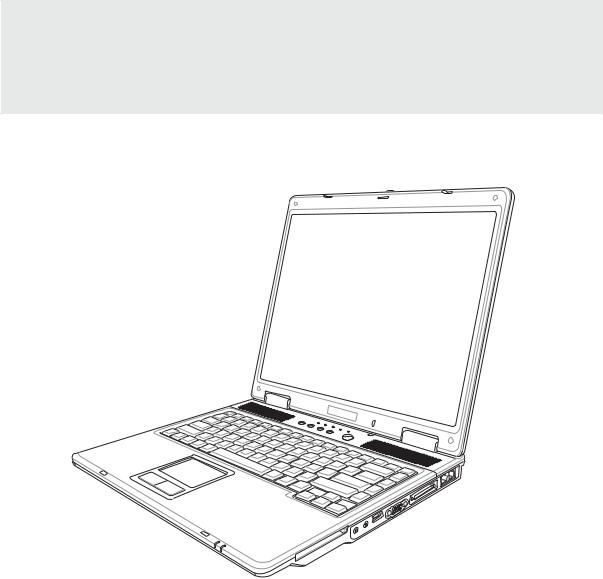
Notebook PC
Hardware User’s Manual
E2219 /Nov 2005

Contents |
|
1. Introducing the Notebook PC |
..................................................................5 |
About This User’s Manual .......................................................................................... |
6 |
Notes For This Manual .......................................................................................... |
6 |
Preparing your Notebook PC ..................................................................................... |
9 |
Top Side ................................................................................................................... |
12 |
Bottom Side ............................................................................................................. |
14 |
Right Side ................................................................................................................ |
16 |
Left Side ................................................................................................................... |
18 |
Front Side ................................................................................................................ |
19 |
Rear Side ................................................................................................................. |
20 |
3. Getting Started ....................................................................................... |
21 |
Power System .......................................................................................................... |
22 |
Using AC Power .................................................................................................. |
22 |
Using Battery Power............................................................................................ |
22 |
Charging the Battery Pack .................................................................................. |
22 |
Powering ON the Notebook PC .......................................................................... |
24 |
The Power-On Self Test (POST) ......................................................................... |
24 |
Battery Care ........................................................................................................ |
24 |
Checking Battery Power ...................................................................................... |
25 |
Restarting or Rebooting ...................................................................................... |
26 |
Powering OFF ..................................................................................................... |
26 |
Special Keyboard Functions .................................................................................... |
27 |
Colored Hot Keys ................................................................................................ |
27 |
Keyboard as Cursors........................................................................................... |
28 |
Microsoft Windows™ Keys ................................................................................. |
28 |
Keyboard as a Numeric Keypad ......................................................................... |
29 |
Switches and Status Indicators ................................................................................ |
29 |
Switches .............................................................................................................. |
29 |
Status Indicators.................................................................................................. |
30 |
2

|
Contents |
4. Using the Notebook PC ......................................................................... |
33 |
Models with Sonoma chipset .............................................................................. |
34 |
Operating System .................................................................................................... |
34 |
Support Software................................................................................................. |
34 |
Pointing Device ........................................................................................................ |
34 |
Using the Touchpad ............................................................................................. |
35 |
Touchpad Usage Illustrations .............................................................................. |
36 |
Caring for the Touchpad ...................................................................................... |
37 |
Storage Devices ....................................................................................................... |
39 |
PC Card (PCMCIA) Socket ................................................................................. |
39 |
Inserting a PC Card (PCMCIA) ........................................................................... |
39 |
Removing a PC Card (PCMCIA) ......................................................................... |
39 |
Optical Drive ........................................................................................................ |
40 |
Hard Disk Drive ................................................................................................... |
42 |
Flash Memory Card Reader ................................................................................ |
42 |
Modem Connection ............................................................................................. |
42 |
Fast-Ethernet Connection ................................................................................... |
45 |
Power Management Modes ..................................................................................... |
45 |
Full Power Mode & Maximum Performance........................................................ |
45 |
ACPI .................................................................................................................... |
45 |
Suspend Mode .................................................................................................... |
45 |
Power Savings .................................................................................................... |
45 |
Power State Summary ........................................................................................ |
46 |
Thermal Power Control ....................................................................................... |
46 |
Stand by and Hibernate....................................................................................... |
47 |
Appendix ..................................................................................................... |
49 |
Optional Accessories ............................................................................................... |
50 |
Glossary ................................................................................................................... |
52 |
Declarations and Safety Statements ....................................................................... |
56 |
Notebook PC Information......................................................................................... |
68 |
3

Contents
4

Introducing the Notebook PC 1
1. Introducing the Notebook PC
About This User’s Manual
Notes For This Manual
Safety Precautions
Preparing your Notebook PC
5

1 Introducing the Notebook PC
About This User’s Manual
You are reading the Notebook PC User’s Manual. This User’s Manual provides information on the various components in the Notebook PC and how to use them. The following are major sections of this User’s Manuals:
1.Introducing the Notebook PC
Introduces you to the Notebook PC and this User’s Manual.
2.Knowing the Parts
Gives you information on the Notebook PC’s components.
3.Getting Started
Gives you information on getting started with the Notebook PC.
4.Using the Notebook PC
Gives you information on using the Notebook PC’s components.
5.Appendix
Introduces you to optional accessories and gives additional information.
User’s |
Manual |
|
Notes For This Manual
A few notes and warnings in bold are used throughout this guide that you should be aware of in order to complete certain tasks safely and completely. These notes have different degrees of importance as described below:
WARNING! Important information that must be followed for safe operation.
IMPORTANT! Vital information that must be followed to prevent damage to data, components, or persons.
TIP: Tips and useful information for completing tasks.
NOTE: Tips and information for special situations.
< > |
Text enclosed in < > or [ ] represents a key on the keyboard; do not actually type the < |
[ ] |
> or [ ] and the enclosed letters. |
|
|
6
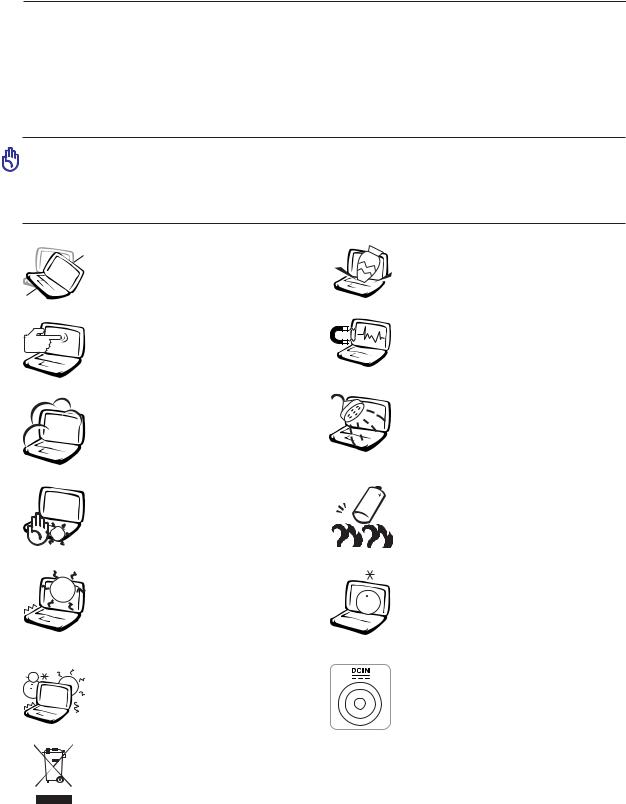
Introducing the Notebook PC 1
Safety Precautions
The following safety precautions will increase the life of the Notebook PC. Follow all precautions and instructions. Except as described in this manual, refer all servicing to qualified personnel. Do not use damaged power cords, accessories, or other peripherals. Do not use strong solvents such as thinners, benzene, or other chemicals on or near the surface.
Disconnect the AC power and remove the battery pack(s) before cleaning. Wipe the Notebook PC using a clean cellulose sponge or chamois cloth dampened with a solution of nonabrasive detergent and a few drops of warm water and remove any extra moisture with a dry cloth.
DO NOT place on uneven or unstable work surfaces. Seek servicing if the casing has been damaged.
DO NOT press or touch the display panel. Do not place together with small items that may scratch or enter the Notebook PC.
DO NOT expose to dirty or dusty environments. DO NOT operate during a gas leak.
DO NOT leave the Notebook PC on your lap or any part of the body while the Notebook PC is turned ON or is charging in order to prevent discomfort or injury from heat exposure.
DONOTexposetoextremetemperatures  above 50˚C (122˚F) or to direct sunlight.
above 50˚C (122˚F) or to direct sunlight. 
 Do not block the fan vents!
Do not block the fan vents! 
SAFE TEMP: This notebook PC should only be used in environments with ambient temperatures between 0°C (32°F) and 35°C (95°F).
DO NOT place or drop objects on top and do not shove any foreign objects into the Notebook PC.
DO NOT expose to strong magnetic or electrical fields.
DO NOT expose to or use near liquids, rain, or moisture. DO NOT use the modem during an electrical storm.
DO NOT throw batteries in fires as they may explode. Check local codes for special battery disposal instructions.
DO NOT expose to extreme temperatures (below 0˚C (32˚F), otherwise the Notebook PC may not boot.
INPUT RATING: Must only receive power input of 19VDC, 3.42A (65W).
The symbol of the crossed out wheeled bin indicates that the product (electrical and electronic equipment) should not be placed in municipal waste. Please check local regulations for disposal of electronic products.
7
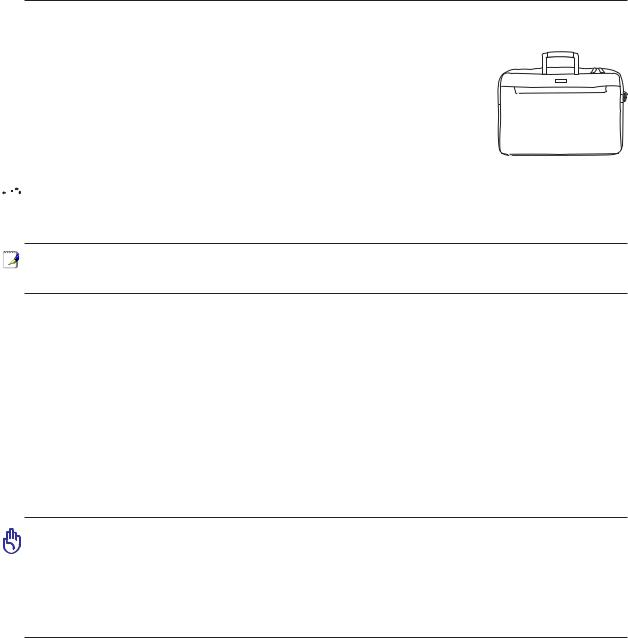
1 Introducing the Notebook PC
 Transportation Precautions
Transportation Precautions
To prepare the Notebook PC for transport, you should turn it OFF and disconnect all external peripherals to prevent damage to the connectors. The hard disk drive’s head retracts when the power is turned OFF to prevent scratching of the  hard disk surface during transport. Therefore, you should not transport the Notebook PC while the power is still ON. Close the display panel and check that it is latched securely in the closed position to protect the keyboard and display panel.
hard disk surface during transport. Therefore, you should not transport the Notebook PC while the power is still ON. Close the display panel and check that it is latched securely in the closed position to protect the keyboard and display panel.
 Cover Your Notebook PC
Cover Your Notebook PC
You can purchase an optional carrying case to protect it from dirt, water, shock, and scratches.
NOTE: The surface glaze is easily dulled if not properly cared for. Be careful not to rub or scrap the Notebook PC surfaces when transporting your Notebook PC.
 Charge Your Batteries
Charge Your Batteries
If you intend to use battery power, be sure to fully charge your battery pack and any optional battery packs before going on long trips. Remember that the power adapter charges the battery pack as long as it is plugged into the computer and an AC power source. Be aware that it takes much longer to charge the battery pack when the Notebook PC is in use.
 Airplane Precautions
Airplane Precautions
Contact your airline if you want to use the Notebook PC on the airplane. Most airlines will have restrictions for using electronic devices. Most airlines will allow electronic use only between and not during takeoffs and landings.
CAUTION! There are three main types of airport security devices: X-ray machines (used on items placed on conveyor belts), magnetic detectors (used on people walking through security checks), and magnetic wands (hand-held devices used on people or individual items). You can send your Notebook PC and diskettes through airport X- ray machines. However, it is recommended that you do not send your Notebook PC or diskettes through airport magnetic detectors or expose them to magnetic wands.
8
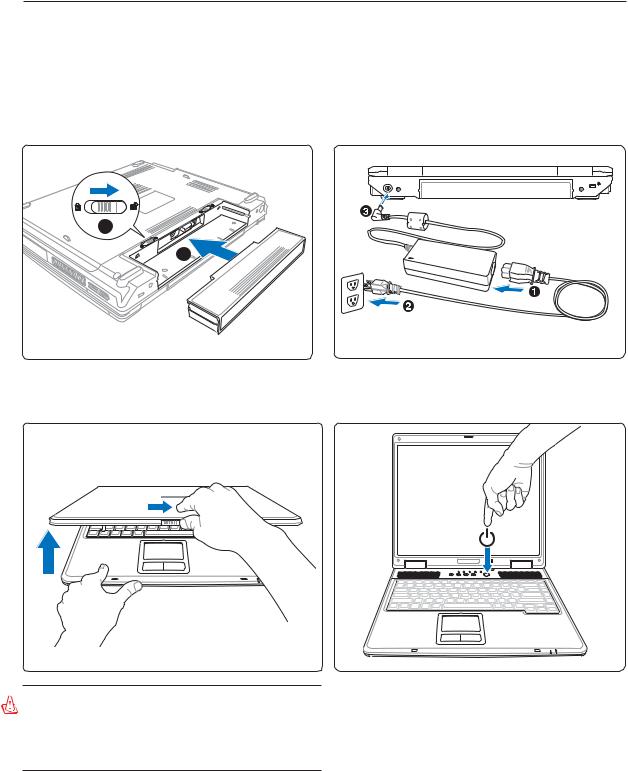
Introducing the Notebook PC 1
Preparing your Notebook PC
These are only quick instructions for using your Notebook PC. Read the later pages for detailed information on using your Notebook PC.
1. Install the battery pack |
2. Connect the AC Power Adapter |
||||||
|
|
|
|
|
|
|
|
|
|
|
|
|
|
|
|
|
|
|
|
|
|
|
|
1
2
3. Open the Display Panel |
4. Turn ON the Notebook PC |
WARNING! When opening, do not force the display panel down to the table or else the hinges may break! Never lift the Notebook PC by the display panel!
Press the power button and release.
(In Windows XP, this button can also be used to safely turn OFF the Notebook PC.)
9
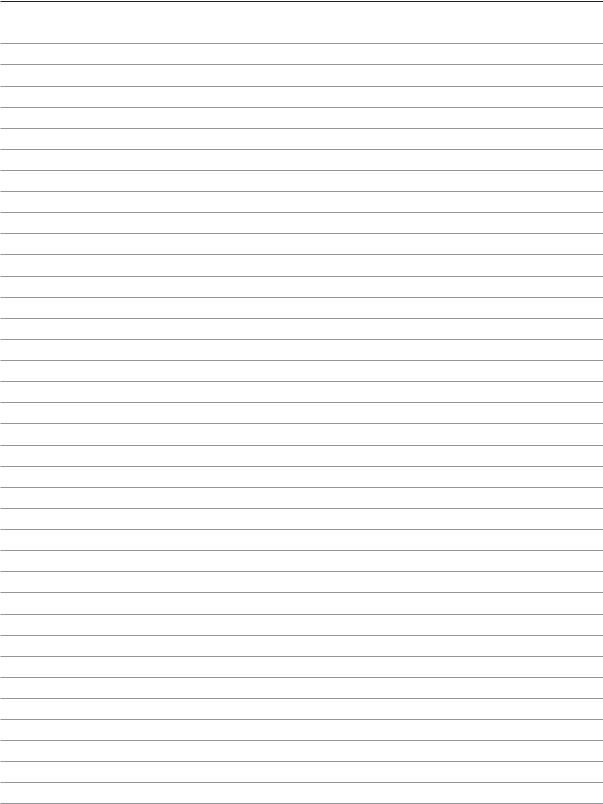
1 Introducing the Notebook PC
10
2. Knowing the Parts
Basic sides of the Notebook PC
11
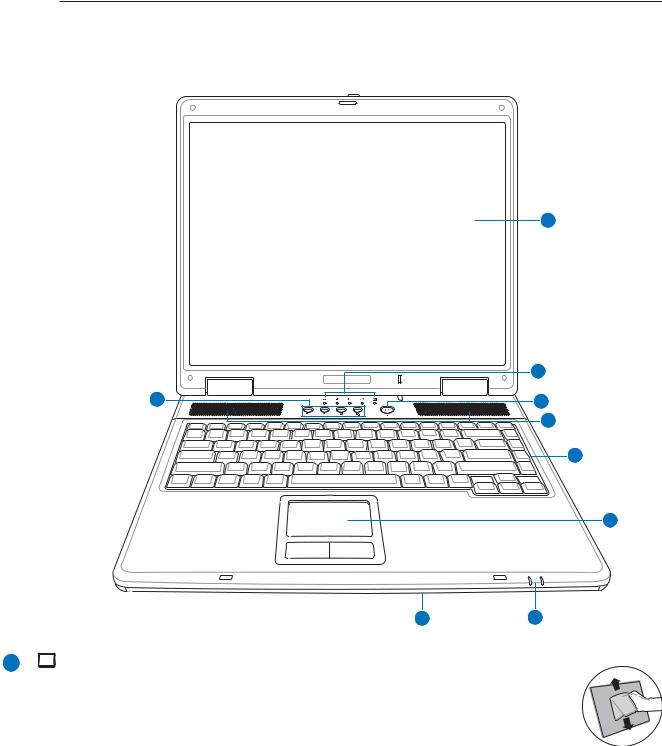
2 Knowing the Parts
Top Side
Refer to the diagram below to identify the components on this side of the Notebook PC.
1
2
9 |
3 |
4
5
6
8 |
7 |
1 |
Display Panel |
The display panel functions the same as a desktop monitor. The Notebook PC uses an active matrix TFT LCD, which provides excellent viewing like that of desktop monitors. Unlike desktop monitors, the LCD panel does not produce any radiation or flickering, so it is easier on the eyes. Use a soft cloth without chemical liquids (use plain water if necessary) to clean the display panel.
12
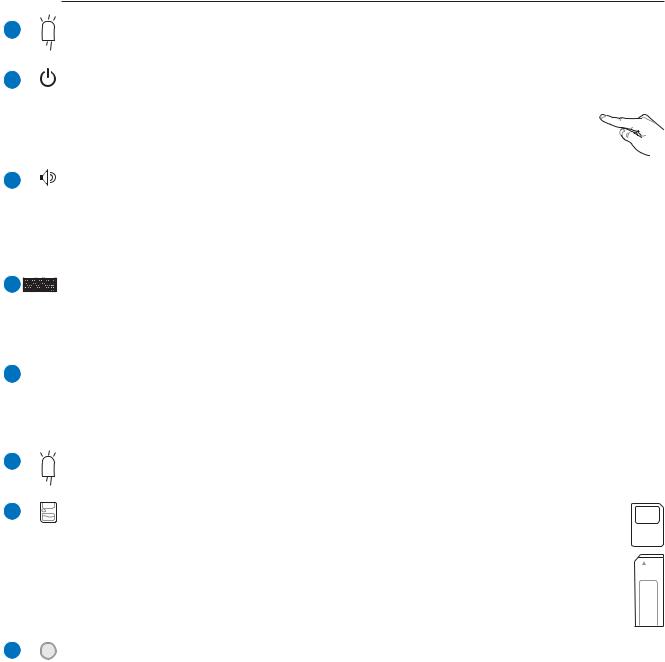
Knowing the Parts 2
2 |
Status Indicators (top) |
|
Status indicator details are described in section 3.
3 |
Power Switch |
|
The power switch allows powering ON and OFF the Notebook PC and recovering from STD. Use the |
|
switch once to turn ON and once to turn OFF the Notebook PC. In Windows XP, this button |
|
can also be used to safely turn OFF the Notebook PC. The power switch only works when |
|
the display panel is opened. |
4 |
Audio Speakers |
|
The built-in stereo speaker system allows you to hear audio without additional attachments. The |
|
multimedia sound system features an integrated digital audio controller that produces rich, vibrant |
|
sound (results improved with external stereo headphones or speakers). Audio features are software |
|
controlled. |
5 |
Keyboard |
|
The keyboard provides full-sized keys with comfortable travel (depth at which the keys can be depressed) |
|
and palm rest for both hands. Two Windows™ function keys are provided to help ease navigation in the |
|
Windows™ operating system. |
6 |
|
|
Touchpad and Buttons |
|
|
||
|
|
|
The touchpad with its buttons is a pointing device that provides the same functions as a desktop mouse. |
|
|
|
A software-controlled scrolling function is available after setting up the included touchpad utility to |
|
|
|
allow easy Windows or web navigation. |
7 |
Status Indicators (front) |
|
Status indicator details are described in section 3. |
8 |
Flash Memory Slot |
|
Normally a PCMCIA or USB memory card reader must be purchased separately in order to |
|
use memory cards from devices such as digital cameras, MP3 players, mobile phones, and |
|
PDAs. This Notebook PC has a built-in memory card reader that can read many flash memory |
|
cards as specified later in this manual. The built-in memory card reader is not only convenient, |
|
but also faster than most other forms of memory card readers because it utilizes the high- |
|
bandwidth PCI bus. |
9 |
Instant Keys |
|
Instant keys allow you to launch frequently used applications with one push of a button. Details are |
|
described in section 3. |
13
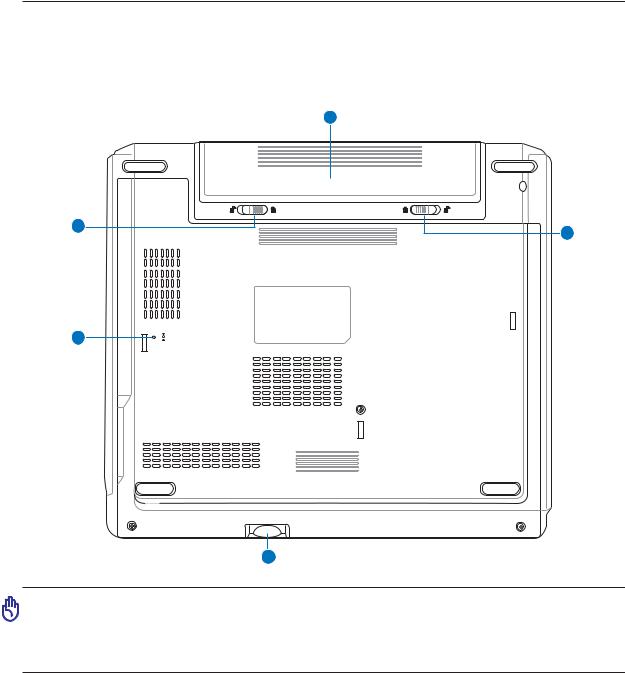
2 Knowing the Parts
Bottom Side
Refer to the diagram below to identify the components on this side of the Notebook PC. Details are given starting from the top and going clockwise.
1
5
2
4
3
IMPORTANT! The bottom of the Notebook PC can get very hot. Be careful when handling the Notebook PC while it is in operation or recently been in operation. High temperatures are normal during charging or operation. DO NOT PUT THE NOTEBOOK PC ON THE LAP OR OTHER PARTS OF THE BODY TO AVOID INJURY FROM THE HEAT.
14
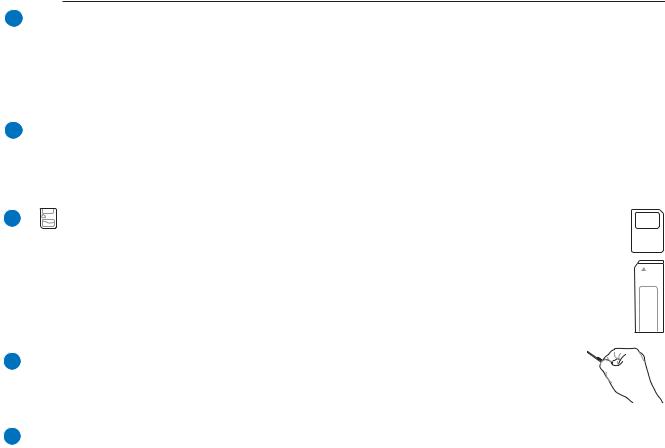
Knowing the Parts 2
1  Battery Pack
Battery Pack
The battery pack is automatically charged when connected to an AC power source and maintains power to the Notebook PC when AC power is not connected. This allows use when moving temporarily between locations. Battery time varies by usage and by the specifications for this Notebook PC. The battery pack cannot be disassembled and must be replaced as a single unit through an authorized vendor.
2  Battery Lock - Manual
Battery Lock - Manual
The manual battery lock is used to keep the battery pack secured. Move the manual lock to the unlocked position to insert or remove the battery pack. Move the manual lock to the locked position after inserting the battery pack.
3 |
Flash Memory Slot |
Normally a PCMCIA or USB memory card reader must be purchased separately in order to use memory cards from devices such as digital cameras, MP3 players, mobile phones, and PDAs. This Notebook PC has a built-in memory card reader that can read many flash memory cards as specified later in this manual. The built-in memory card reader is not only convenient, but also faster than most other forms of memory card readers because it utilizes the highbandwidth PCI bus.
4 
 Emergency Shutdown Button
Emergency Shutdown Button
In case your operating system cannot properly turn OFF or restart, the shutdown button can be pressed with a straightened paper clip to shutdown the Notebook PC.
5  Battery Lock - Spring
Battery Lock - Spring
The spring battery lock is used to keep the battery pack secured. When the battery pack is inserted, it will automatically lock. To remove the battery pack, this spring lock must be held in the unlocked position.
15
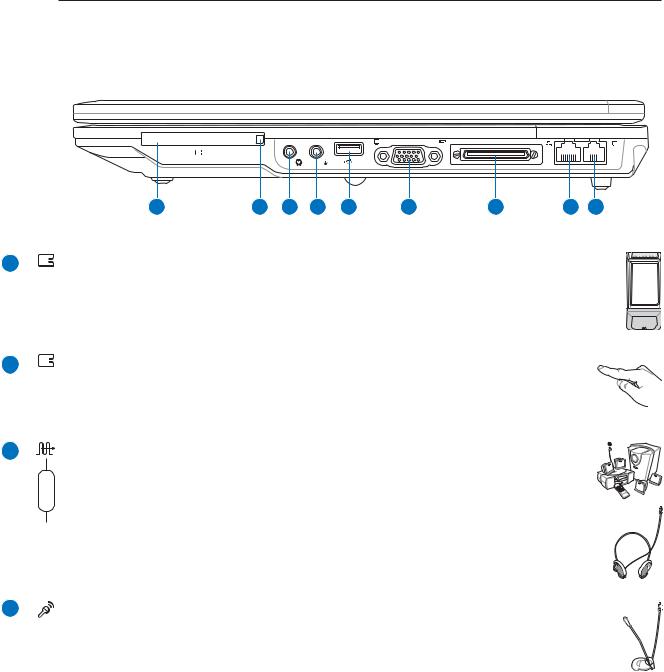
2 Knowing the Parts
Right Side
Refer to the diagram below to identify the components on this side of the Notebook PC.
1 |
2 |
3 |
4 |
5 |
6 |
7 |
8 |
9 |
1 |
PC Card Slot |
One PCMCIA 2.1 compliant PC Card socket is available to support one type I/II PC card. The socket supports 32-bit CardBus. This allows accommodation of Notebook PC expansion options such as memory cards, ISDN, SCSI, Smart Cards, and wireless network adapters.
2 |
PC Card Eject |
Use this button to eject optional PC cards. This button is mechanical (not electronic) so a small force is required and the Notebook PC does not have to be turned ON to eject PC cards.
3 |
SPDIF Output Jack |
Combo
This jack provides connection to SPDIF (Sony/Philips Digital Interface) compliant devices for digital audio output. Use this feature to turn the Notebook PC into a hi-fi home entertainment system.
 Headphone Output Jack
Headphone Output Jack
The stereo headphone jack (1/8 inch) is used to connect the Notebook PC’s audio out signal to amplified speakers or headphones. Using this jack automatically disables the built-in speakers.
4 |
Microphone Input Jack (Mic In) |
The mono microphone jack (1/8 inch) can be used to connect an external microphone or output signals from audio devices. Using this jack automatically disables the built-in microphone. Use this feature for video conferencing, voice narrations, or simple audio recordings.
16
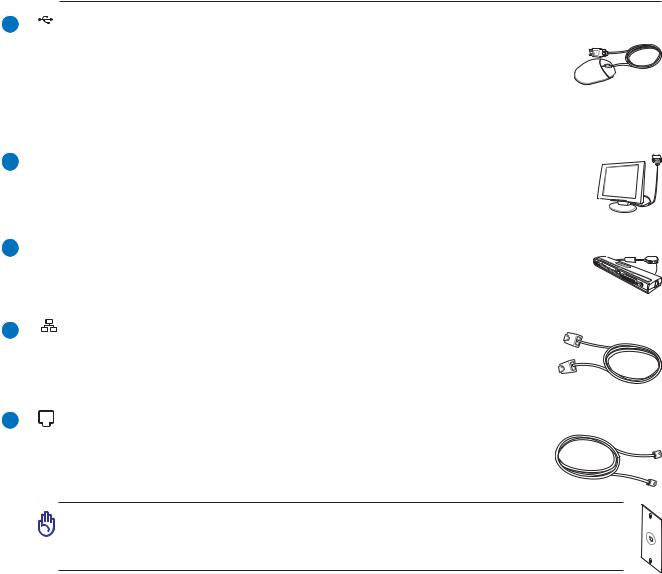
5
6
7
Knowing the Parts 2
2.0 USB Port (2.0/1.1)
The Universal Serial Bus is compatible with USB 2.0 or USB 1.1 devices such as keyboards, pointing devices, cameras, hard disk drives, printers, and scanners connected
in a series up to 12Mbits/sec (USB 1.1) and 480Mbits/sec (USB 2.0). USB allows
many devices to run simultaneously on a single computer, with peripherals such as USB keyboards and some newer monitors acting as additional plug-in sites or hubs. USB supports hot-swapping of devices so that most peripherals can be connected or disconnected without restarting the computer.
 Display (Monitor) Output
Display (Monitor) Output
The 15-pin D-sub monitor port supports a standard VGA-compatible device such as a monitor or projector to allow viewing on a larger external display.
 Expansion Port
Expansion Port
The expansion port provides an easy-to-use docking solution to desktop peripherals and other accessories through a single connector.
8 |
LAN Port |
The RJ-45 LAN port with eight pins is larger than the RJ-11 modem port and supports a standard Ethernet cable for connection to a local network. The built-in connector allows convenient use without additional adapters.
9 |
Modem Port |
The RJ-11 modem port with two pins is smaller than the RJ-45 LAN port and supports a standard telephone cable. The internal modem supports up to 56K V.90 transfers. The built-in connector allows convenient use without additional adapters.
IMPORTANT! The built-in modem does not support the voltage used in digital phone systems. Do not connect the modem port to a digital phone system or else damage will occur to the Notebook PC.
17
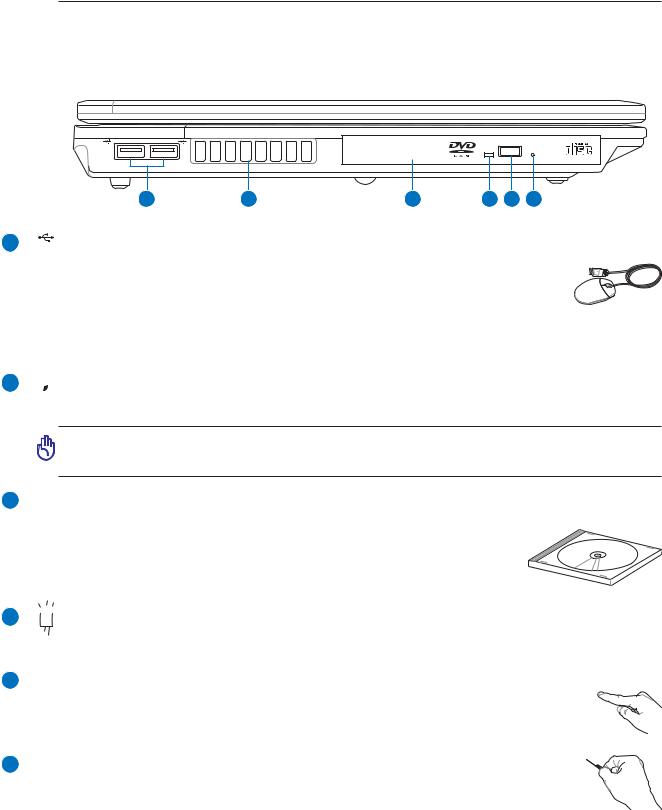
1
2
3
4
5
6
2 Knowing the Parts
Left Side
Refer to the diagram below to identify the components on this side of the Notebook PC.
1 2 3 4 5 6
2.0 USB Port (2.0/1.1)
The Universal Serial Bus is compatible with USB 2.0 or USB 1.1 devices such as keyboards, pointing devices, cameras, hard disk drives, printers, and scanners connected
in a series up to 12Mbits/sec (USB 1.1) and 480Mbits/sec (USB 2.0). USB allows
many devices to run simultaneously on a single computer, with peripherals such as USB keyboards and some newer monitors acting as additional plug-in sites or hubs. USB supports hot-swapping of devices so that most peripherals can be connected or disconnected without restarting the computer.

 Air Vents
Air Vents
The air vents allow cool air to enter and warm air to exit the Notebook PC.
IMPORTANT! Make sure that paper, books, clothing, cables, or other objects do not block any of the air vents or else overheating of the Notebook PC may occur.
 Optical Drive
Optical Drive
The Notebook PC comes in various models with different optical drives. The Notebook PC’s optical drive may support compact discs (CD) and/or digital video discs (DVD) and may have recordable (R) or re-writable (RW) capabilities. See the marketing specifications for details on each model.
 Optical Drive Activity Indicator
Optical Drive Activity Indicator
The optical drive activity indicator shows when data is being transferred by the optical disk drive. This indicator will light in porportion to the data size transferred.
 Optical Drive Electronic Eject
Optical Drive Electronic Eject
The optical drive eject has an electronic eject button for opening the tray. You can also eject the optical drive tray through any software player or by right clicking the optical drive in Windows™ “My Computer.”
 Optical Drive Emergency Eject
Optical Drive Emergency Eject
The emergency eject is used to eject the optical drive tray in case the electronic eject does not work. Do not use the emergency eject in place of the electronic eject.
18
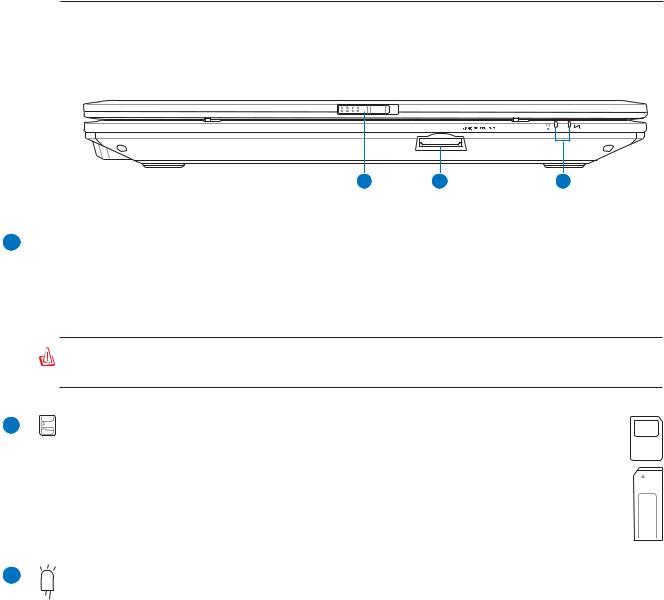
Knowing the Parts 2
Front Side
Refer to the diagram below to identify the components on the front side of the Notebook PC.
1 |
2 |
3 |
1  Display Panel Latch
Display Panel Latch
One spring-loaded latch on the front of the Notebook PC locks the display panel in the closed position when the Notebook PC is not in use. To open the display panel, negotiate the latch with your thumb and lift up the display panel while holding the latch. Slowly tilt the display panel forward or backward to a comfortable viewing angle.
WARNING! When opening, do not force the display panel down to the table or else the hinges may break! Never lift the Notebook PC by the display panel!
2 |
Flash Memory Slot |
Normally a PCMCIA or USB memory card reader must be purchased separately in order to use memory cards from devices such as digital cameras, MP3 players, mobile phones, and PDAs. This Notebook PC has a built-in memory card reader that can read many flash memory cards as specified later in this manual. The built-in memory card reader is not only convenient, but also faster than most other forms of memory card readers because it utilizes the highbandwidth PCI bus.
3 |
Status Indicators |
Status indicator details are described in section 3.
19

1
2
3
2 Knowing the Parts
Rear Side
Refer to the diagram below to identify the components on this side of the Notebook PC.
|
|
|
|
|
|
|
|
|
|
|
|
|
|
|
|
|
|
|
|
|
|
|
|
|
|
|
|
|
|
|
|
|
|
|
|
|
|
|
|
|
|
|
|
|
|
|
|
|
|
|
|
|
|
|
|
|
|
|
|
|
|
|
|
|
|
|
|
|
|
|
|
|
|
|
|
|
|
|
|
|
|
|
|
|
|
|
|
|
|
|
|
|
|
|
|
|
|
|
|
|
|
|
|
|
|
|
|
|
|
|
|
|
|
|||
1 |
2 |
|
3 |
|
|
|||||||
 Power (DC) Input
Power (DC) Input
The supplied power adapter converts AC power to DC power for use with this jack. Power supplied through this jack supplies power to the ASUS Notebook PC and charges the internal battery pack. To prevent damage to the ASUS Notebook PC and battery pack, always use the supplied power adapter.
 Battery Pack
Battery Pack
The battery pack is automatically charged when connected to an AC power source and maintains power to the Notebook PC when AC power is not connected. This allows use when moving temporarily between locations. Battery time varies by usage and by the specifications for this Notebook PC. The battery pack cannot be disassembled and must be replaced as a single unit through an authorized vendor.
 Kensington® Lock Port
Kensington® Lock Port
The Kensington® lock port allows the Notebook PC to be secured using Kensington® compatible Notebook PC security products. These security products usually include a metal cable and lock that prevent the Notebook PC to be removed from a fixed object.  Some security products may also include a motion detector to sound an alarm when moved.
Some security products may also include a motion detector to sound an alarm when moved. 
20
3. Getting Started
Using AC Power
Using Battery Power
Powering ON the Notebook PC Checking Battery Power Restarting or Rebooting Powering OFF the Notebook PC Special Keyboard Functions Switches and Status Indicators
21
